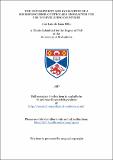The development and evaluation of a microprocessor-controlled bioreactor for use in developing countries
Abstract
A laboratory scale fermenter control system, based on a Z80 microprocessor operating at 4 MHz, has been developed. The system has the following features: 1 -" 8 Kbytes of RAM and 4 Kbytes of EPROM (with extra space for another 4 Kbytes); 2 -" Two serial links (RS232c);3-" An analog/digital converter with an 8 channel multiplexer and an opto-triac system for switching control devices (heater, peristaltic pumps); 4 -" Four interface cards to connect the parameter sensors. This system has the advantage that it is based on well established (though not state-of-the-art) microelectronic technology (Z80 chips) widely available in the world at reasonable prices. This, plus the fact that both hardware and software were locally designed, means that it is truly 'portable' in the sense that, with limited resources, copies can easily be constructed in developing countries (the idea is that Mark-II will be built in North East Brazil to support research into yeast fermentation technology). The control system was evaluated in batch and chemostatic growth modes. Both modes were used to investigate the growth kinetics of a genetically engineered Saccharomyces cerevisiae strain (BC55) carrying the plasmid pCYG4 which directs 10 fold more NADP-GDH activity than wild type cells. Batch culture experiments showed that the presence of plasmid increased ammonia uptake by the cells but did not improve biomass or ethanol yield compared to wild type cells. Under carbon-limitation NADP-GDH activity was in phase with GOGAT and penicillinase activity. NADP-GDH and GOGAT activities were inversely proportional to intracellular ammonia concentration and proportional to intracellular L-glutamate concentration. Under nitrogen limitation (using ammonia as limiting substrate) GOGAT activity increased, but NADP-GDH and penicillinase activity remained at the same level as under carbon limitation. Using L-glutamate as nitrogen source NADP-GDH activity was very low and GOGAT and penicillinase activities were undetectables with an increase in NAD-GDH activity. Oscillations found in enzyme activities and intracellular metabolite concentration under carbon and nitrogen limitation experiments are a consequence of a mixed culture (the presence of cells with plasmid GDH (gdh+ cells) and cells without plasmid GDH (gdh- cells)) with changing concentrations of the 2 populations.
Type
Thesis, PhD Doctor of Philosophy
Collections
Items in the St Andrews Research Repository are protected by copyright, with all rights reserved, unless otherwise indicated.

